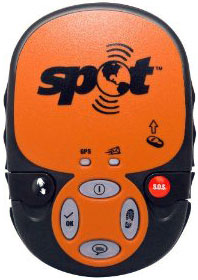
$220 SAVE $130 = 37.0% Western Digital 16.0TB Western Digital Ultrastar DC HC550 3.5-in… in Storage: Hard Drives
|

|

|

|

|

|

|

|

|

|

|
SPOT GPS Messenger (and PLB discussion)
 @AMAZON
@AMAZON
I often photograph alone in obscure locations in Yosemite or the White Mountains or Death Valley. This carries some risks as I scamper along, so I now always carry the SPOT GPS Messenger.
The 2010 model has several new functions, including OK, Custom and Tracking buttons. The reason I carry it is just in case I break a leg or similar: for its SOS feature, uploaded via GPS satellites. Not as good as a PLB (see below), but I deem it enough for my use.
The SPOT requires a service plan to function, so you’ll need to keep renewing its functionality every year or two— an ongoing cost. I also paid for the emergency rescue insurance plan, so it won’t cost me $20K for search and rescue charges.
The SPOT combines a margin of safety with fun stuff, like tracking and "OK" messages, and so for casual adventurers, it’s perfect. It also weighs only 117 grams (I weighed it with batteries), far lighter than most PLB units, which range from 450 to 700 grams or so—heavy. The SPOT is light enough to be strapped onto one’s arm with the supplied strap.
James G writes:
I'm not sure what your experience with the SPOT beacon has been but they have been on my shit list since using it on the JMT several years ago. My son and I had planned a specific resupply time and location but our travel speed was better than anticipated. I carried the SPOT (generation 2) and would activate it over each mountain pass where there was surely a clean satellite view unobstructed by trees or narrow canyon walls. My girlfriend and brother were watching the SPOT signals to determine our progress and decide the timing of the pack train resupply.
Unfortunately only about 1/3 of our signals went through even though the link light was green and implied that we had connected with the satellite. Without reliable information as to our actual travel time, our support people had to use their best judgment and my son and I ended up waiting two days at Charlotte Lake for our supplies to arrive.
The moral of the story is don't believe the lights on the SPOT. Leave it on all the time. Expect the satellite connection to be spotty and signal to not go through. If you are serious, consider a PLB. Perhaps SPOT has improved their product or service since then, but caution is warranted.
DIGLLOYD: this is good to know. I’ve never had to use the SPOT for anything serious, so I cannot say if this is a one-off issue or a general concern.
Personal Locator Beacon (PLB) for serious use
A personal locator beacon (PLB) is a time-proven way to go, with a powerful transmitter, as well as a homing signal. A PLB is a purpose-built unit for saving your butt, and if that’s your only goal, it’s definitely a better choice. And it won’t cost you subscription fees, so the higher up-front cost is paid for after a few years.
The SPOT lacks the 121.5 MHz homing signal that all 406 PLBs have, and so a PLB is a serious unit for riskier adventures. SPOT is fun GPS, with an emergency signal that is likely to work, but should not be construed as a PLB.
There is some controversy @AMAZON over the reliability of the SPOT service. In particular, what if the "OK" message does not get sent? However, every single “OK” message I’ve sent has gone through on the multiple trips I used it on, and so far it has been very accurate. That said, the areas I frequent are wide-open, with a clear view of the sky.
Bottom line: for fun with GPS, and some measure of security, SPOT is great, but a PLB is the right way to go for true emergencies.
Operating the SPOT GPS Messengers
Operation of SPOT is simple. You set it up in advance, along with your email contacts to receive email when you press the OK button. If you are in serious trouble, you press the SOS button, and hopefully some nice folks show up before things get really ugly. If you bang your head on a rock, be sure to press the SOS button before becoming unconscious.
Below is what an “all OK” email looks like, as resulted from pressing the OK button at the summit of Mt Dana. The email includes a link you can click to view in Google Maps.
Latitude:37.89979 Longitude:-119.22114 GPS location Date/Time:10/05/2009 12:25:53 PDT Click the link below to see where I am located. https://maps.google.com/maps?f=q&hl=en& geocode=&q=37.89979,-119.22114&ll=37.89979,-119.22114&ie=UTF8&z=12&om=1 Message:All OK.
Reader reports
I received this interesting email from a reader.
As luck would have it, one of our photography group was deep in a wilderness yesterday here in Arkansas and fell and broke a leg and collarbone. Sent a 911 message via Find Me Spot that he just purchased. A SAR team reached him six hours later and have spent the entire night trying to get him out - still not out this morning. It is a tough location and no heli access since it is heavily wooded. They've literally had to cut their way through the dense forest. No doubt the Spot saved his life.
— Tim E, Arkansas
Great story! But there are some important details:
A couple more facts that have become known about the photographer and FindMeSpot that might interest you. The first pings from the unit were inaccurate - about 1/4 mile off (I assume from the unit just being turned on - it took a while for the signal to take hold). The rest of the pings coming from the unit were good, and remained stable. Even with the GPS coordinates though, the rescue team had trouble finding him at first - it was dark by the time they reached the immediate area where he was, which was extremely rugged to begin with. The only way they located the injured photographer was by SEEING the blinking light on the FindMeSpot!
We also now know that the photographer fell off the top of a waterfall and landed in the shallow pool below and broke his pelvis and other bones. He was unable to pull himself completely out of the water, and so he remained in the water for more than six hours before being found. Luckily he had his FindMeSpot on his person instead of in his camera bag. So a note to other photographers - be sure to carry your FindMeSpot in your vest or pocket and not in your camera bag!
It took them 12 hours to EVAC this guy (nearly all in darkness), a total of 18 hours after he first fell before he made it out to the helicopter.
One last bit of info - another photographer came within 100 yards of the injured man four hours after the fall and never saw him.
Regarding the 1/4 mile off, all GPS units I’ve used have trouble in densely-wooded areas, and my guess is that the SPOT used its last good signal for starters. A 406MHz PLB has a homing signal, and the SPOT does not. Because my outdoor excursions are generally in wide-open areas, I don’t see this as a significant issue for myself, but should be though through carefully.
Finding the injured party is a very serious issue— I almost always carry my powerful Lupine Betty, because my excursions frequently return near dusk or after dark; as a bonus it is capable of emitting an alpine distress signal or SOS for a week or longer, depending on the battery used. Lupine lights
Seagate 22TB IronWolf Pro 7200 rpm SATA III 3.5" Internal NAS HDD (CMR)
SAVE $100

















